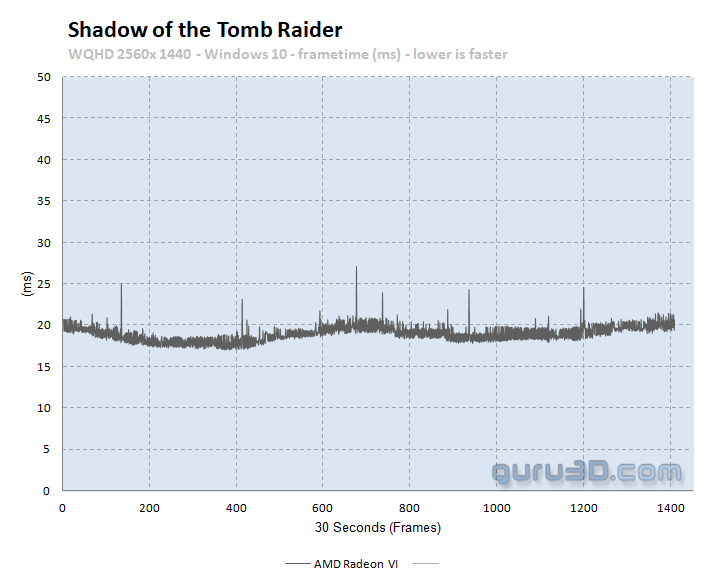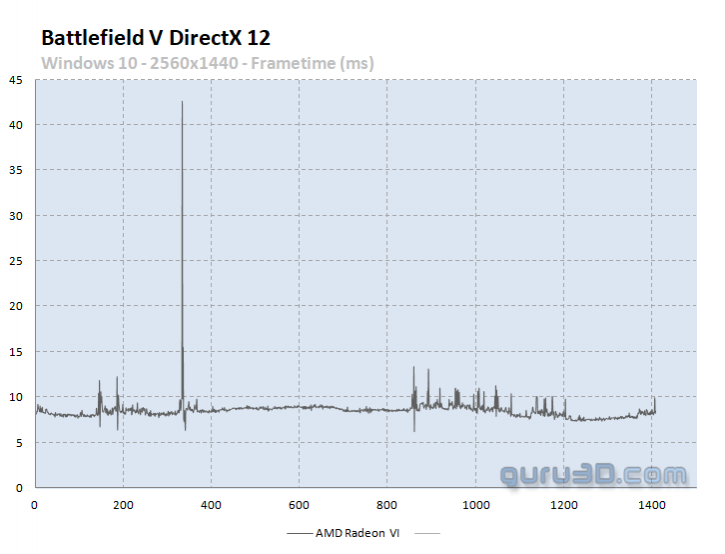Frametime Analysis: Shadow of the Tomb Raider - Codemasters F1 2018 - Battlefield V
Frametime and latency performance
The charts below will show you graphics anomalies like stutters and glitches in a plotted chart. Frame time and pacing measurements.
| Frame time in milliseconds |
FPS |
| 8.3 | 120 |
| 15 | 66 |
| 20 | 50 |
| 25 | 40 |
| 30 | 33 |
| 50 | 20 |
| 70 | 14 |
- FPS mostly measures performance, the number of frames rendered per passing second.
- Frametime AKA Frame Experience recordings mostly measures and expose anomalies - here we look at how long it takes to render one frame. Measure that chronologically and you can see anomalies like peaks and dips in a plotted chart, indicating something could be off.
We have a detailed article (read here) on the methodology behind it all. Basically the time it takes to render one frame can be monitored and tagged with a number, this is latency. One frame can take say 17 ms. Higher latency can indicate a slow framerate, and weird latency spikes indicate a stutter, jitter, twitches; basically, anomalies that are visible on your monitor. What these measurements show are anomalies like small glitches and stutters that you can sometimes (and please do read that well, sometimes) see on screen. Below I'd like to run through a couple of titles with you. Bear in mind that Average FPS often matters more than frametime measurements.
As you might have observed, we're experimenting a bit with our charts to give it a little more clarity. At the left side, you can see the frame time in milliseconds (ms). At the x-axis, 30 seconds of the game spread out over roughly 1400~1500 frames. Please understand that a lower frame time is a higher FPS (!), so for these charts, lower = better. Huge spikes would be stutters, thick lines would be bad frame pacing, and the graduate streamlining is framerate variation.
Above frame time latency/pacing measurements (frame-times). The graphics card is configured at a monitor resolution of 2560x1440, or (Wide) Quad HD. There are barely noticeable stutters visible or measured, this, however, is the game engine and is something you would see with any card. For frame-times, lower is better. Frame pacing wise you can see a bit of a thick line, there is a 2 maybe 3ms variations per rendered frame. Something AMD will need to look at, but not visible on screen (monitor).
Codemasters 2018 Formula 1 - this is the scripted time-demo based on the internal benchmark with the Australia circuit where we do a lap. We have some stutters, again, this is the 100% game engine related, nothing to worry about as the car tries to overtake or bump into a very crowded field of opponents.
Battlefield V then, overall this is a really good result. The one massive spike is a grenade or mortar exploding close-by, this is perfectly normal behavior.




